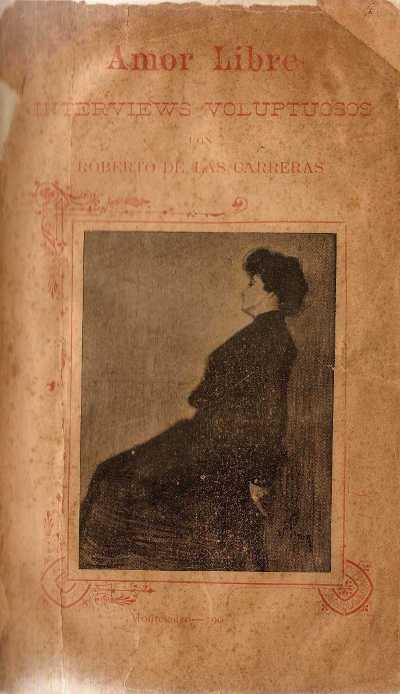Interviews voluptuosos
May 20th, 2009

This is the cover of Amor libre, published in 1902 by Roberto de las Carreras in Montevideo, Uruguay. The publication was preceded by an advance of the first chapter, and by two adds, that appeared in the anarchist newspaper La rebelión in 1902 in Montevideo. The first add said:
Free Love, by Roberto de las Carreras.
At this time is being bound the book Free Love, that our comrade Roberto de las Carreras with his pen, a sharp stiletto against the bourgeoisie, is writing. We feel very sorry for some impatient comrades that allowed themselves to criticize the first interview published in this newspaper. After the reading of the book Free Love, they will be convinced that our eulogies to the writer, who adhered to our ranks with unbridled audacity, were not exaggerated.
Regarding this new work, from now on we can reveal to the comrades that it will be a vivid example in all literature. There are vibrant pages, his virile heart beats with the impulse of the most beautiful feelings.
This add was a response to the protest that the advance of the book arouse among the readers of La rebelión, who were upset by its erotic content. The second add, published a few days later, said:
This Sunday the book on free love written by our comrade Roberto de las Carreras will come out.
Free Love is composed of 92 pages of abundant material excellently printed. In its artistic cover, it shows an attractive female figure in voluptuous attitude, abandoned to love. The price of the present edition is of 30 cents for each copy, and the earnings, if any, once the expenses are deducted, will be allocated to publish a novel of social revolutionary propaganda.
Order at the offices of La rebelión, Orillas del Plata 281.
Published in 1902, Amor libre was an early example of pornographic literature in Latin America, and it was heavily influenced by the anarchist theories on free love, that proposed the abolition of family as a step against the structures of authority in capitalist society. The image in the cover talks to us about the limits of eroticism at the turn of the century. The act of provocation carried by the publication of this book, was a mean of intervention to push forward these same limits. The commercial gimmick of the adds reveal an ironic stand toward the market strategy, placing that same strategy at the service of a revolutionary aim. The use of technical novelties, such as photography, and the selection of a refined set of fonts, were elements that gave this mix of erotica and anarchist theory the appeal of a commodity ready for consumption. The circulation of ideas that anarchist presses allowed at the end of the 19th. Century in Latin America provoked a rather unexpected encounter between the lettered elite and the radical thought that socialists and anarchists were bringing from Europe. According to the adds, the publication didn’t obey to a market calculation. The publisher didn’t expect a profit, and promised to use the potential earnings for a new publication, with revolutionary character. In this case, the economy behind the book is simple: the expensive publication was funded by the author, an extremely rich dandy who allowed himself to donate the potential earnings to the anarchist typographer, so the late can push forward his own editorial agenda. Anarchists and socialists were crucial in defining the trends of cultural circulation at the turn of the century in the Southern Cone, thanks to the expertise several of them had in graphics arts. It is noteworthy that the first unions of workers in that region were established by graphic workers.

